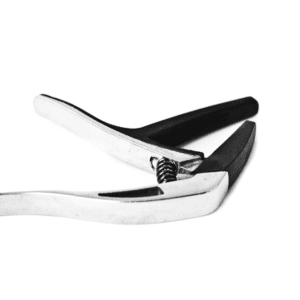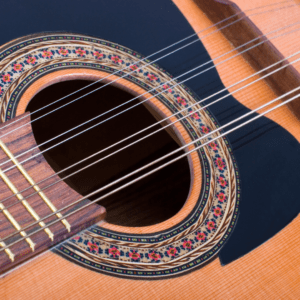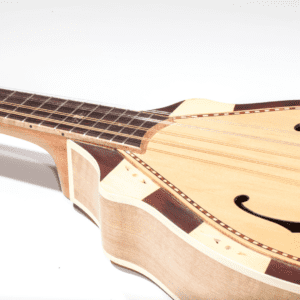
A mandolin pick is a vital part of the tone, dynamics, and attack that you can get out of your instrument. Beginners can be forgiven for thinking that a pick is a pick, and which you use doesn’t matter at all. Yet, a little bit of experience will show that it makes a tremendous difference. Using the right pick is essential if you’re planning on taking your playing to the next level.
After you’ve chosen your instrument and found the right strings for your needs, choosing a pick is a vital part of molding your tone. Differences in size, shape, and material will all affect the tone you’re able to get out of your instrument. You’ll find different picks produce tones with varying degrees of brightness and mellowness. They even sound different depending on the instrument itself, so a bit of experimentation is necessary to find your ideal pick.
Read on for a roundup of some of the best picks currently on the market.
| 1. Our Top Pick – Fender Premium Picks Sampler 24 picks per pack in thin, medium and heavy gauge in a range of different colors. | Buy on Amazon | |
| | 2. Best Rounded-Mandolin Pick – D’Andrea PRO-346 Rounded Triangle Plectrum Rounded pick with rich and warm tone. Offers good roll-offs and attack suited for strumming. | Buy on Amazon |
| | 3. Best Thick Mandolin Pick – Golden Gate MP-12 Deluxe Tortoise Style Mandolin Pick Large, heavy pick in a traditional shape that offers a powerful sound. Japanese made. | Buy on Amazon |
| | 4. Best Medium Mandolin Pick – Fender 351 Shape Premium Picks Traditional and comfortable shape with round sound. Choose from a range of colors. | Buy on Amazon |
| | 5. Best Heavy Mandolin Pick – Jim Dunlop Primetone Semi-Round 1.3mm Sculpted Plectra Made from Ultrex known for its strength and durability. Choose from different materials, shapes and textures to suit you. | Buy on Amazon |
| 6. Best Sharp-pointed Mandolin Pick – Dunlop Jazz III Pick Pack, Red Nylon,1.38mm Medium sharp jazz pointed pick favored by many virtuosos. Broad and tactile grip with a warm sound and smooth attack. | Buy on Amazon |
Top mandolin pick on the market Reviewed
Our Top Mandolin Pick – Fender Premium Picks Sampler
The Fender premium collection comes with 24 mandolin picks in total; 8 heavy gauge, 8 medium gauge, and 8 light gauge picks. All the picks are standard shape with a wider body and a rounded tip. Choose from ocean turquoise, abalone, shell, assorted moto colors, or confetti.
All the picks in this collection are celluloid, itself considered one of the best materials for mandolin picks.
Celluloid is known for its ability to produce a rich tone with a traditional feel. The tone is round and warm and the striking surface is the right amount of soft. The fact that this pack comes with different gauges means you can find out firsthand which best suits your instrument and playing style.
Pros;
- 24 picks in heavy, medium, and thin gauges.
- Range of colors and designs included.
- Let you find out first hand which kind of pick works best for you.
Cons;
- Some people have expressed displeasure with not receiving the full range of colors and designs advertised.
- Some people claim that the thin gauge picks are too thin to be of much use.
Best Rounded-Mandolin Pick –D’Andrea PRO-346 Rounded Triangle Plectrum
The D’Andrea PRO 346 is industrial-grade thermoplastic made in the USA. With a thickness of 1.5mm on an attractive tortoiseshell design, this pick is sure to attract many with its appealing looks and specs. They’re ideal for the warm and rich tones sought after by acoustic players, as the softer attack allows the pick to just roll off the strings.
They’re made from a standard triangle shape with rounded edges, meaning if you wear one side down you can turn the pick around to use the other corners. So they can last longer. That is if you don’t lose them before, of course.
The rounded edge also gives you greater volume control than sharp-edged picks do.
Pros;
- Wider design helps keep them in your hand.
- The softness of the picks gives them superb attack and roll-offs.
- Rich and warm sounds well-suited for acoustic strumming.
- You can flip the pick and play your instrument with another edge if one wears down.
Cons;
- As the picks are quite soft they lack enough volume for some people.
Best Thick Mandolin Pick – Golden Gate MP-12 Deluxe Tortoise Style Mandolin Pick
The Golden Gate picks are extra big, heavy, and large. They are triangle-shaped with rounded edges. As such they’re perfect for getting that characteristic mandolin tremolo. Made in Japan from nitrocellulose, they are stiff; a trait often preferred by acoustic instrumentalists.
The heaviness of the pick adds real depth to every note you strike. Every sound is rendered with power with the Golden Gate MP. On top of this, users claim to have no difficulty in playing single notes either, which is good news.
On a purely aesthetic note, the design of this pick is striking, with the Golden Gate printed on top of a tortoiseshell background.
Pros;
- Classic triangle shape.
- Heavy, large, and easy to handle.
- Powerful sound.
- Heavyweight emphasizes each note without much effort.
- Japanese made.
- Rounded edges.
Cons;
- Comes with 12 identical picks per pack.
Best Medium Mandolin Pick – Fender 351 Shape Premium Picks
For a comfortable playing experience and familiar feel, consider trying the Fender 351 shape premium pick. The 351 shape is a classic so you have the benefit of knowing that many thousands of people before you over the years have used this pick with success.
The surface is smooth and the tone is warm and round musically. This pick is medium gauge making it perfect for those after the strength, power, and emotional control of a heavy pick without losing the flexibility and ease of a thinner one. Each pack comes with a dozen picks; enough to keep you going for a while.
Made of sturdy and reliable celluloid, these picks come in a range of beautiful colors for you you choose from to suit your personality. The comfort, performance, and flexibility of these tried and tested picks should stand up to the needs of just about every mandolinist out there.
Pros;
- Traditional and comfortable shape.
- Warm and round tone.
- Medium gauge means they are neither too thick nor too thin, and are strong enough for raw emotions yet still flexible.
- Made of celluloid.
- Choose from a range of colors.
Cons;
- The smooth surface can make them slippery if you sweat.
Best Heavy Mandolin Pick Jim Dunlop Primetone Semi-Round 1.3mm Sculpted Plectra
The Primetone Sculpted plectrums are specifically made for the mandolin so you’ll find they glide off the strings and generate that pure and clear voice of the mandolin. The design is round, unlike the common V-shaped design, which allows for fast and clean runs as well as strumming.
Made from Ultrex, a material that offers durability and strong tonal definition. Choose from different shapes, shapes, and textures. Jim Dunlop also allows you to print your artwork on the picks so you can have a fully customized item. This particular pack contains three 1.3mm thick round plectra.
With excellent quality and feel, this pack is outstanding value.
Pros;
- Made from Ultrex, known for its durability and flexibility.
- Offers a satisfying tonal definition.
- Available in a wide range of shapes, materials, textures.
- Can include custom artwork.
Cons;
- Only three picks per pack, making it likely you’ll have to reorder soon.
Best Sharp-pointed Mandolin Pick – Dunlop Jazz III Pick Pack
The Jazz guitar pick has a cult following around and is favored by virtuosos for many reasons. Whilst it’s marketed as a guitar pick there’s no reason you can’t use it on your mandolin.
The Jazz pick offers a warm tone that glides over the strings with ease and comfort. The pick is broad which aids with grip and the tip is sharp for unparalleled control of your sound. Perhaps that’s why this is the most popular jazz pick on the planet.
The attack is smooth as and the tone is warm. The picks are red with a tactile gripping surface and each pack contains 6 picks.
Pros;
- Medium sharp-pointed jazz tip for added precision.
- Classic tone and feel.
- Broad grip with a sharp tip
- Tactile gripping surface.
- Warm sound with a smooth attack.
Cons;
- Takes a bit of getting used to.
Mandolin Pick Buying Guide
What Is a Mandolin Pick?
Mandolin picks don’t differ much from your standard guitar pick so you can use a guitar pick on a mandolin. Acoustic guitar picks will tend to be too soft for the mandolin. Many mandolin players prefer a pick with a rounded edge, so a pointed electric guitar pick may not be the best choice for the mandolin.
Ultimately it is your playing style that will dictate the kind of pick you choose to use.
It’s all down to personal preference, with different picks having different characteristics, strengths and weaknesses.
Why Is The Pick You Use Important?
The mandolin pick you choose will have a huge impact on your sound, speed, and volume. Usually, harder picks (0.70mm and above) tend to sound better, but this is not a hard and fast rule.
The pick is what bridges the gap between you and the strings of your instrument. The pick is literally an extension of your fingers. Once you start thinking of it like this you can appreciate the importance of having one that works well for you.
As picks are inexpensive and easily misplaced, it’s a good idea to have many lying around. Take the time to try as many different models as you can to find what works well for you and your playing style. You may even find different preferences for different playing styles and situations.
What Are The Different Shapes of Mandolin Picks?
The most common mandolin pick shapes are the classic, triangle, jazz, teardrop and the shark fin. The most popular shape is the classic.
Below are some common shapes of different mandolin picks.
Teardrop
This shape is becoming increasingly popular nowadays and is most commonly used for acoustic instruments.
Jazz
A jazz pick is somewhat smaller and has a more pointed edge to give it greater precision.
Classic
This is the most common type of pick shape and is suited to strumming and getting that characteristic tremolo of the mandolin.
Triangle
Triangle size picks are usually the largest kind and are most often used for acoustic instruments and bass.
Sharkfin
The sharkfin is a versatile pick that can be used for either picking or strumming.
A sharp-pointed pick will give you more attack and a brighter tone which works well for solo playing. Round-pointed picks offer a more mellow sound and work well for strumming.
What Are The Different Thickness Levels (Gauge) of Mandolin Picks?
The thickness of a pick will determine the sound and volume, as well as durability. The thicker the pick, the greater dynamic variability you can achieve. Thicker picks are best for electric instruments and solos, whilst thinner picks work well for purely acoustic instruments.
Light
Thin or light picks usually range between .4 to .60 mm.
Medium
Medium picks are most often somewhere between .60 to .80 mm and are used in both acoustic and electric instruments.
Heavy
Picks with a thickness between .80mm and above are considered heavy.
Thin vs Thick Picks: Which Should I Go For?
Thin Picks
Generally, thin picks do well in situations or playing styles where you’re after; Generally, thin picks do well in situations or playing styles where you’re after;
A brighter tone. This is because their surface area accentuates higher frequencies.
A more contained dynamic range. This is because the flexibility of the pick limits the dynamic variability. This can be especially useful and desirable in a studio setting.
Strumming an acoustic instrument. Lesser variability in the dynamic range of notes serves to highlight chords well and bring clarity to their individual notes.
Thick Picks
Thick picks generally are good for:
More mellow tones. The weight and rounded edges of thick picks emphasize lower frequencies over higher ones.
Offering a wider dynamic range. You have more control over volume and attack with these kinds of picks.
Electric and lead playing. The greater clarity and distinction that thick picks offer makes them suited to eclectic playing especially leads and solos. They’re also good at isolating individual notes if there’s any distortion.
Heavier picks do need more dexterity and control in your fingers than their lighter counterparts though, so this is something worth bearing in mind.
Why Is The Construction Material Of The Mandolin Pick Important?
Different materials produce different timbre, volume, durability, and comfort. The most common and perhaps the best material used to make mandolin picks is nylon. There are different compositions of nylon used by different companies, each with distinct names and characteristics.
Throughout history, musicians have tried to make picks out of everything imaginable. The most coveted material of all came from the Atlantic Hawksbill Tortoise, known simply as tortoiseshell. In the early 1900s plastic picks began to gain popularity, gradually overtaking tortoiseshell.
In 1973 the Atlantic Hawksbill Tortoise was declared critically endangered and the plastic picks that were being built to emulate tortoiseshell took over.
Nylon is the most common material for pick construction and there are many different formulas of it that each has its specific characteristics. For example, celluloid offers a warm and equal tone, whereas Ultram will provide a louder and more direct sound.
Nylon picks are softer with a textured grip and are best suited for lightweight and flexible picks.
Celluloid is thicker with a smoother texture when compared to nylon.
Acetal, known as Tortex (a popular line of picks by Dunlop) has a gritty texture that resembles that of tortoiseshell.
Fender is renowned for its celluloid picks, whilst Dunlop is known for its Tortex and nylon picks.
Also, it’s worth adding that, even if a pick is on the thin side, if it’s made from a harder material, then the added stiffness will give it characteristics reminiscent of thicker picks. The reverse also holds; that thicker picks made from softer materials often resemble thinner picks.
What’s The Relationship Between Mandolin Picks and Playing Styles?
Different pick shapes and sizes suit different playing styles and musical genres. For precise melodies and plucking, a smaller pick with a pointier edge is preferable. For more rhythmic playing and strumming, a bigger pick with wider edges works better.
How Will The Texture of The Mandolin Pick Affect Your Playing?
Texture creates friction between the pick and your fingers. The more textured a pick is, the easier it’ll be to grip. A textured pick will also add more color and character to your tone. A smooth textured pick will give you a clearer, more natural sound.
So there’s somewhat of a tradeoff between grip and tone. How much of the balance you’re willing to concede will depend on the style of music you play and your preferences.
The edges of the pick will also affect your sound. Sharp edges will give you more attack and a brighter tone. Smooth edges will offer you a clean and warmer tone.
Can You Use A Guitar Pick For The Mandolin?
Yes, You can use a guitar pick for the mandolin. Mandolin picks tend to be stiffer and sturdier than the average guitar pick, often too stiff to use on a guitar. The important thing is you use a medium to heavy gauge of guitar pick for mandolin.
Using a thinner pick more common with guitarists on the mandolin would make it harder to play quickly. The pick will still be flexing when it should be sounding a note.
Yet, given the number of picks on the market these days for both guitar and mandolin, there’s no reason why you couldn’t try a guitar pick on your mandolin. As I’ve mentioned many times already, it all depends on the tonal profile you’re after, the kind of music you play, and your unique style as a musician.
The best way is to try as many different kinds of picks for yourself. This way you’ll find out first hand what helps your playing. You’ll learn what shapes, materials, and thick or thinness work for you and what doesn’t. In time you’ll figure out what helps and what impedes your musical expression. The only way to do this is by trying for yourself.
Given that, like mandolin players, guitarists also have preferences of what works best for them, there’s no reason why your preferences as a guitarist couldn’t overlap with those of yours as a mandolinist. Also bear in mind that people have used all different kinds of material for picks over the years, and there have been huge changes in what’s available since the 1970s.
To Sum Up
The type of pick you chose to use on your mandolin can have a radical effect on the tone you’re able to extract from your instrument. It’s just as important as the construction of the mandolin itself and the strings. Ultimately it’s how all these three elements blend with the player that dictates what kind of sounds you’ll be able to produce.
As there are so many variables that affect a pick, such as the material used, the gauge of the pick, and the type of edge. We recommend the Fender Premium Picks Sampler, especially for beginners. Here you’ll receive 24 picks in medium, thin and heavy gauges so you can see firsthand what kind of pick works best for you.
Last update on 2023-04-27 / Affiliate links / Images from Amazon Product Advertising API






